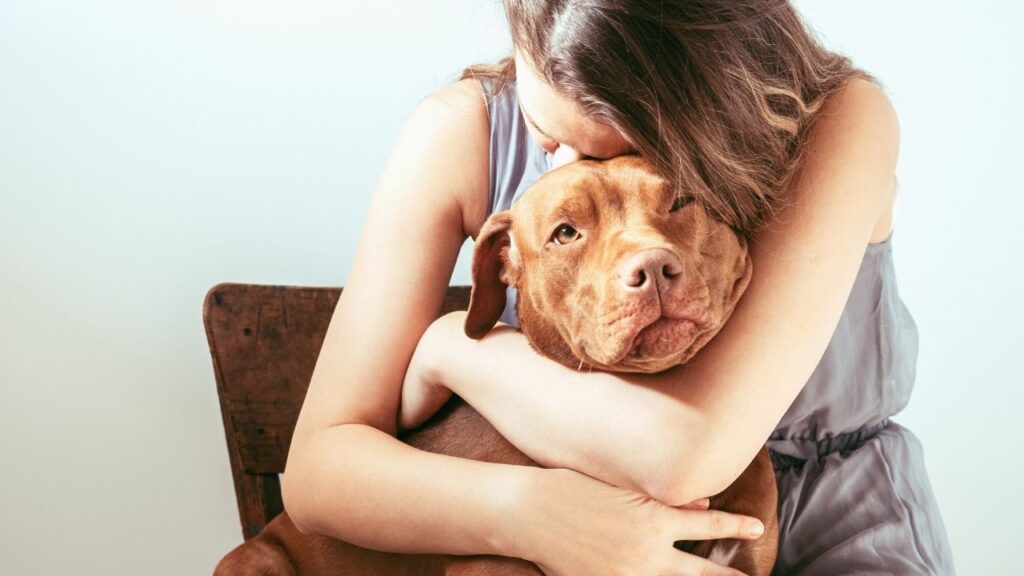The illness or loss of a family dog is a difficult and inevitable experience, but with a little help from you, your children can learn how to cope with the strong emotions that come with this experience.
Key Takeaways
- It is important to include children in conversations about your dog’s cancer or putting your dog to sleep, so you can help them understand what is going on.
- When talking to your children about these hard topics, be sure to consider your child’s age and maturity level, so you can offer age-appropriate explanations.
- It’s important to give your child the time and space they need to process and grieve in their own individual way. Honoring their process and being supportive of their needs will help them cope.
Consider Maturity Levels When Talking to Children
Talking to children about the illness and death of their beloved dogs is essential, but it is important to know what they can and can’t understand at their stage of life. Taking your child’s age and maturity level into consideration will help you offer an age-appropriate explanation for what is happening with your dog.
Below are some general guidelines for talking to children, but keep in mind that each child is unique in their development, and it is best to follow their lead when having these hard conversations.1
Children Under Five
Children in this age group often do not fully understand what is going on when their dog is diagnosed with a serious illness. They may believe it is a temporary situation that will soon be resolved,1 though children as young as 3 may understand that death is irreversible.2 While they are grieving, you may notice they appear to regress to a stage you thought they had outgrown.
Children 5-8 years old
Children in this age group generally have a better understanding of illness and death, but do not understand it as it relates to them on a personal level.1 They may express anger and may visualize death as an entity or being, such as an angel or a monster.1
Children 9-12 years old
Children in this age group understand fully that illness and death are an inevitable part of life and often respond to a diagnosis or death in a manner similar to that of adults.1 They may be very curious and have a lot of questions. Older children in this age group may be more reluctant to show their feelings.
Children 13 and up
Teens generally have an adult understanding of illness and death. They are often reluctant to show their emotions, despite evidence that they often experience grief more deeply than other age groups.1
How to Talk to Kids About Cancer
It is important to keep children involved in conversations about your dog’s illness. If your dog receives a terminal diagnosis, talk to your child as soon as possible about the diagnosis, treatment options, and prognosis. Explain these things in simple terms that can be understood at your child’s maturity level.
Allow them time to process and ask questions and then help them enjoy the time they have left with their beloved dog. Kids are very intuitive and will know something is wrong whether you tell them or not. Failure to involve them in the conversation may result in your child seeking information from sources that are less reliable and can lead to misinformation and unnecessary fear and anxiety about the diagnosis.
Setting Boundaries During Treatment
If your dog is ill and receiving treatment, it is important to discuss this with your children as well. Explain that your dog does not feel well and needs to rest.
Keep in mind that a dog who is sick or in pain may not behave the same way she always has. For example, a painful dog may bite or have a much lower tolerance for physical interaction than she previously had.
Younger children may not understand these implications, so it is important that you watch their interactions closely to ensure they are not being too rough with your dog. It may be a good idea to give your dog her own space to be alone and rest when needed.
Explaining Death and Euthanasia
Eventually, the time will come when your dog dies, or euthanasia is necessary. Conversations around death and euthanasia are hard even for adults, but it is very important to have honest and age-appropriate conversations on these topics with your children. It is also important to include children in conversations about euthanasia so that they can understand what is happening and feel included in the decision.
Some tips for helping explain death and euthanasia to your child:
- Avoid euphemisms. Children are very literal thinkers. Using euphemisms such as “put to sleep” can confuse or mislead them and hinder their understanding.2 For example, the term “put to sleep” can cause children to relate sleeping with death and result in fear or anxiety about going to sleep at night.1
- Use simple language. Use proper medical terms such as “died” and “dying” and help your child understand what that means. In cases of euthanasia, explain that your dog is very sick and will not get better, and that the veterinarian will give them medicine to help them die without any more pain.
- Don’t blame the veterinarian or God. This can lead to mistrust or fear of healthcare providers and make children fearful that God could come for them or other family members next.1
- Allow them to choose if they want to be present and support their decision. Being present for euthanasia can help children get closure and understand that death is permanent,1 but do not force them to be there. If they do not want to be present for the euthanasia, you may offer to let them see the body afterwards.
Talking to Children About Grief
Just like adults, the grieving process for children is unique to the individual and they should be allowed to grieve in their own way. There should not be a time limit placed on their grief, but if they are not coping well three to six months after your dog’s death, it may be helpful to discuss that with a mental health professional.3
Children naturally know how to grieve better than adults,4 but there are steps you can take to help them cope while they mourn:
- Encourage your child to write about or draw their dog. Art therapy has been shown to increase positive emotions during the grieving process,5 and can help children explore and express their feelings.
- Allow them to talk about their dog when they need to. Ask them questions about their favorite memory of their pet, or what they miss most about their pet.
- Let other important people in your child’s life know what is going on, such as close neighbors, teachers, etc., so they can also offer support.
- Let children see your own emotions and let them know that crying and sadness is normal after the loss of a loved one.
- Hold a memorial service or help your child find other ways to help them memorialize their dog, such as creating a memory box to hold mementos (collars, favorite toys, paw prints, etc.).
It is normal to want to protect your child from the intense emotions that come with grief. By being honest when talking to children, validating their emotions, and honoring their individual grieving process, you can help them learn invaluable coping skills they will need throughout life.
- The Ohio State Veterinary Medical Center. Helping Children Cope with the Serious Illness or Death of a Companion Animal. 2013. https://vet.osu.edu/vmc/sites/default/files/files/companion/HTB/Helping%20Children%20Cope%20Printable%20%282013%29.pdf. Accessed January 21, 2023.
- Longbottom S, Slaughter V. Sources of children’s knowledge about death and dying. Philos Trans R Soc Lond B Biol Sci. 2018;373(1754):20170267. doi:10.1098/rstb.2017.0267
- Center TD. Helping Children Cope with Pet Loss. The Drake Center for Veterinary Care. https://www.thedrakecenter.com/resources/materials/helping-children-cope-pet-loss. Accessed January 23, 2023.
- Wood T. Helping Kids Cope with Pet Loss. Synergy Magazine / School of Veterinary Medicine Magazine. https://magazine.vetmed.ucdavis.edu/fall-2021-news-articles/helping-kids-cope-pet-loss. Published November 15, 2021. Accessed January 23, 2023.
- Green D, Karafa K, Wilson S. Art therapy with grieving children: Effect on affect in the dual-process model. Art Therapy. 2020;38(4):211-215. doi:10.1080/07421656.2020.1823197.
Topics
Did You Find This Helpful? Share It with Your Pack!
Use the buttons to share what you learned on social media, download a PDF, print this out, or email it to your veterinarian.








